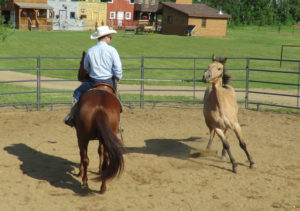In my last post, I started talking about the consequences of what I call Emotional Horsemanship, in which we interpret the horse through a distorting lens of human emotion. One of the common problems with this way of viewing horses is that when the horse does something we don’t like, we tend to get angry or defensive, blaming the horse for its “bad attitude” and feeling justified to get after the horse. In truth, if this sort of thing happens to you, you have allowed yourself to be pulled away from a centered stance of positive calm into an unbalanced one of negative emotionality. This is the exact opposite of what a good leader does.
A good leader is someone who knows what to do and stays calm when challenges appear – they don’t get angry, defensive, scared, or otherwise rattled under pressure. By maintaining their equilibrium, they set an example that draws others towards a feeling of safety and peace. This is what our horse’s need from us in order to willingly put their lives in our hands, which we quite literally ask them to do all the time.
Of course, we are human beings, and as such, we are all going to get emotionally triggered in certain moments. The key is to understand that when we feel frustrated, disappointed, or annoyed with our horses, it is always our responsibility, as the leader, to find a solution that brings the horse to a better place, not a worse one. When you keep that aim in mind, you recognize that punishment and dominance are not the answer.
In this sense, working with horses is a great way to help you find your best self, as horses will show you very clearly whether you are adding value to their experience or adding stress. It is also helpful to remember that in working with horses, we are taking a self-preserving prey animal and trying to drastically change the way they naturally think and respond. This is inevitably going to involve overcoming challenges, and there will be lots of ups and downs. But, if you can learn to take those difficult moments in stride and see the challenges as a normal part of the process, they won’t be so likely to pull you away from the centeredness you want to maintain.

A good leader maintains their equilibrium, which helps their horse feel safe even when challenges appear. Here, Josh is not ruffled by the excited horses around him, which helps his young saddle horse, Bentley, keep his cool as well.

There are always moments in horse training where things are not going perfectly, but if we recognize that this is simply part of the process and nothing to get upset about, we minimize the impact of those moments, both for us and for our horses.
Josh Nichol

Really well said Josh! And such valuable information that we can take into all areas of our lives… Parenting, teaching, friendships etc. Thank you for taking the time to share your thoughts!
The more I practice this, which I have learned from you the better it goes for both the horse and me. It is another tool and perhaps the most powerful tool we have in horsemanship.
Josh, I am really trying to contain a calmness in my work. We had a great experience yesterday. Started with ground work, it went well, we even had canters on both leads! When we were riding something outside the arena caused a spook which I was actually able to turn into a soft balanced walk, full of upward energy, I have never felt this before. It was an amazing feeling. 🙂
These blog posts are very helpful to those of us who are not able to train in person with you as often as we need! I almost need to read some of them before every training session!